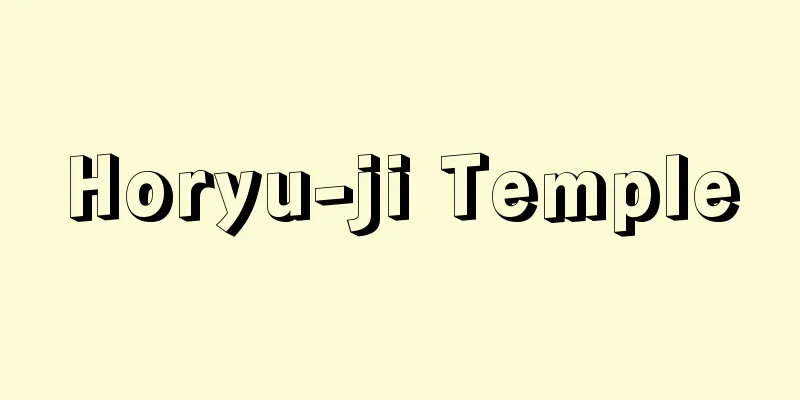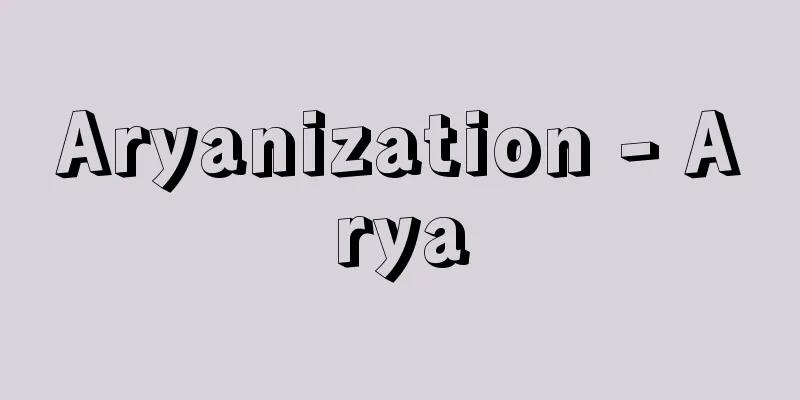Horyu-ji Temple

|
The head temple of the Shotoku sect, located in Ikaruga Town, Ikoma County, Nara Prefecture. It is also known by other names such as Ikaruga Temple (also written as Ikaruga Temple or Ikaruga Temple) and Horyugakumon Temple. It is one of the Seven Great Temples of Nara. [Michio Sato] historyAccording to the inscription on the halo of the seated Yakushi Nyorai statue in the main hall, Emperor Yomei, praying for his recovery from illness, summoned Emperor Daio (Empress Suiko) and Prince Shotoku to vow to build the temple and the Yakushi statue, but passed away before he could accomplish his wish. Empress Suiko and Prince Shotoku followed his will and completed the temple and the Yakushi statue in the 15th year of the reign of Empress Suiko (607). This is confirmed by the "Kenshin Tokugyo Kuketsusho" and "Kokin Mokurokusho", which state that "construction began in the 2nd year of the reign of Empress Suiko and was completed 15 years later". However, there are various theories regarding the construction date, such as the reign of Emperor Sushun as recorded in the "Toji Odaiki", the theory that it was in the 7th year of the reign of Suiko as recorded in the "Kofuku-ji Nenkinki", and the theory that it was in the 21st year of the reign of Suiko as recorded in the "Kofuku-ji Ryaku Nenkinki". In any case, the Shaka Nyorai Triad in the Kondo was created in 623, the year after Prince Shotoku's death, so it cannot be older than this. In 598, the prince donated 500,000 taisho (approx. 1,000 shiro) of land from Harima Province to Horyuji Temple, and later donated 100 cho of rice paddies from Harima Province in 606 and over 270 cho each in 609, building an economic foundation for the temple. The temple grounds were located to the west of Ikaruga Palace, where the prince lived and conducted government affairs from 605 to 622. In 643 (the second year of the reign of Empress Kogyoku), Soga no Iruka attacked the prince's son, Prince Yamashiro no Oe, and Ikaruga Palace was burned down, but Horyuji Temple escaped the fire. However, according to the Nihon Shoki, the temple was burned down by lightning in 670 (the 9th year of the reign of Emperor Tenchi), and the temple complex that was rebuilt afterwards is said to be the current Horyuji Temple complex. In response to this theory of the fire in the 9th year of the reign of Emperor Tenchi, there is no record of the fire in the Horyuji Garan Engi Namo Naru Ryuki Zaizaicho and other documents related to Horyuji Temple, so a debate arose over whether or not Horyuji Temple should be rebuilt. From the Taisho to the Showa era, a heated debate unfolded between historians who trusted the Nihon Shoki and art historians who argued from a stylistic perspective. However, due to excavations at the site of Wakakusa Garan in 1939 (Showa 14), the theory that it was rebuilt has now become the accepted theory. According to this, the original Horyuji temple complex was located at a site called Wakakusa Garan, located southeast of the current temple complex. The remains of the pagoda's core stone and the foundations of the main hall and pagoda have been discovered at the same site, and it has been discovered that the layout of the temple complex was in the Shitennoji style, with the pagoda and main hall lined up in a straight line from north to south, with the central axis tilted about 20 degrees west of the north (the current Horyuji temple is tilted 4 degrees west, a difference of 16 degrees), which is almost the same as the orientation of the Ikaruga Palace ruins. It has also been discovered that the roof tiles were not multi-petaled as they are today, but had a single-petal lotus pattern like those at Asuka-dera and Shitennoji. Furthermore, when the Kondo was dismantled and repaired between 1968 and 1969 (Showa 43 and 44), it was discovered that the foundation stones of the Kondo were reused from burnt foundation stones of the previous temple complex. The rebuilt Horyuji Temple was rebuilt in a different location to the northwest of the old Wakakusa Garan, but the exact date of reconstruction is unknown. However, because the clay statues of the Shaka Nehan statue in the five-story pagoda and the Kongorikishi statues in the middle gate were made in 711 (Wado 4), it is believed that the main hall, five-story pagoda, middle gate, and corridors were built during the reign of Empress Jito (reigned 686-689, reigned 690-697), and the sutra repository and other buildings were built in the early 8th century, completing the various halls. In 739 (Tenpyo 11), the monk Gyoshin built a temple complex on the site of the Ikaruga Palace, with the octagonal Yumedono hall at its center. Today, the temple complex with the main hall and five-story pagoda is called the Saiin, while this is the Joguo-o-in temple complex, known as the Toin. The Yumedono is the oldest surviving octagonal hall, and within it is enshrined the principal image of the Guze Kannon Bodhisattva, said to be a life-size portrait of Prince Shotoku. 100 years after Gyoshin's construction, the priest Dosen completed restoration of the hall, and seated statues of Sozu Gyoshin and Dosen are enshrined side by side within the building. Later, in 925 (Encho 3), the Great Lecture Hall at Horyuji Temple burned down and was rebuilt. The various buildings have been repaired several times. In particular, repairs during the Kamakura period included the expansion and reconstruction of the Shariden and Eden Halls in the Eastern Temple in 1219 (Jokyu 1), remodeling of the various buildings similar to the reconstruction in 1230 (Kanki 2), and the reconstruction of the Seien Hall, Shoryoin, Nishimuro and Sankyoin, the Eastern Temple Prayer Hall, and the Eastern Temple Bell Tower, which completely renewed the appearance of the temple complex. In the Edo period, the Keicho (1600-1606) and Genroku (1690-1707) major repairs were carried out, and the materials of each hall were replaced. Furthermore, from 1934 (Showa 9) to 1956, the Horyu-ji temple complex underwent the Great Showa Restoration, during which all buildings were dismantled and repaired, and restored to their original appearance except for the altered parts (a ceremony to mark the completion of the Great Showa Restoration was held in 1985). During this time, the murals in the Kondo Hall were unfortunately lost in fire in January 1949, but were replicated and reconstructed in 1968. The Great Treasure House was then completed, and many temple treasures, including those preserved in the Kofuzo Treasure House, are now housed and exhibited. It is well known that Prince Shotoku composed and lectured on the "Sangyogisho" (Commentary on the Three Sutras) (Commentary on the Sūtra, Commentary on the Vimalakirti Sutra, Commentary on the Lotus Sutra), and this tradition has been well preserved. Horyuji Temple was the center of learning in Nara as a training center for the four sects of Hosso, Sanron, Vinaya, and Shingon, and many high priests, including Dosen, lived there and produced many scholars of the Abhidharma-Yuishiki school. According to an old map from 1585 (Tensho 13), there were 62 sub-temples, and the temple flourished as a center of worship of the prince, and has been maintained and managed by organizations such as the Prince Shotoku Support Association since the Meiji period. In 1950, the Shotoku sect was founded as a symbol of the prince's virtues, and it became its head temple. [Michio Sato] Temples and EventsThe current Horyu-ji temple grounds consist of the Western Temple Compound and the Eastern Temple Compound, and include over ten sub-temples. A long Tsuiji wall stretches out on either side of the Great South Gate, which serves as the temple's main gate. The Western Temple Compound is arranged in the Horyuji style, with the five-story pagoda to the west and the Golden Hall to the east, and the Golden Hall, five-story pagoda, inner gate and corridor are the world's oldest wooden structures that convey the architectural style of the Asuka period. Outside the corridor, on the east side are the East Room, Seirei-in, Concubine Room, Tsuma-muro, Tsunafuzo, Hosodono, and Jikido, while on the west side are the West Room and Sankyo-in. The Eastern Temple Compound is centered around the Yumedono Hall and consists of the worship hall, Shariden Hall, Eden Hall, corridor, bell tower, and Denpo Hall. Many of these buildings are designated as national treasures or important cultural properties, and the temples house many precious Buddhist statues, paintings, and crafts, making them a great treasure trove of Japanese art history. In 1993, the Buddhist monuments in the Horyu-ji area were registered as a World Heritage Site (World Cultural Heritage). After the Meiji Restoration, Horyu-ji Temple also fell into decline, and in 1878 (Meiji 11), it donated part of its treasures to the Imperial Family and received a grant. These are called the Horyu-ji Temple Treasures, and are currently stored and exhibited at the Tokyo National Museum. Major annual events include the Shariko (January 1-3) held at the Toin Shariden, the Kondo Shusho-e (January 8-14), the Saiendo Shunie (February 1-3), the Eshiki (March 22-24), and the Geango (May 16-August 15). The Shunie is held in front of the Yakushi Nyorai Buddha, and the Tsuina ceremony held on the third night as the final prayer is well-known. During the Oeshiki, gorgeous offerings such as birds and flowers made from rice flour are left in the Seiryo-in temple to praise Prince Shotoku. [Michio Sato] "Horyu-ji Temple," edited by Suzuki Yoshikichi and Kuno Ken (Original Color Japanese Art 2, 1966, Shogakukan)" ▽ "Horyu-ji Temple," revised and expanded edition by Machida Koichi (1987, Jiji Press)" ▽ "Horyu-ji Temple, revised and expanded edition, edited by the Nara Six Great Temples Grand View Publishing Committee (Nara Six Great Temples Grand View vols. 1-5, 1999-2001, Iwanami Shoten)" ▽ "Horyu-ji Temple and the Temples of Ikaruga" (Complete Collection of Art from Ancient Japanese Temples 2, 1979, Shueisha)" [References] | | | | | | | | | | |Source: Shogakukan Encyclopedia Nipponica About Encyclopedia Nipponica Information | Legend |
|
奈良県生駒(いこま)郡斑鳩(いかるが)町にある聖徳(しょうとく)宗総本山。斑鳩寺(鵤寺、伊可留我寺とも書く)、法隆学問寺などの異称がある。南都七大寺の一つ。 [里道徳雄] 歴史草創の由来は、金堂の薬師如来坐像(やくしにょらいざぞう)光背銘によると、用明(ようめい)天皇が病気平癒を念じ、大王天皇(推古(すいこ)天皇)と聖徳太子を召して造寺と薬師像の造立を誓願したが果たさず崩御した。推古天皇と聖徳太子はその遺命を受けて、推古天皇15年(607)に寺と薬師像を完成したという。これは『顕真得業口訣抄(けんしんとくごうくけつしょう)』『古今目録抄』などにも「推古2年起工15年完成」とあって確かめられる。しかし、『東寺王代記』の記す崇峻(すしゅん)天皇の代、『興福寺年代記』の推古7年説、『興福寺略年代記』の推古21年説など、建立年代をめぐって諸説がある。いずれにせよ、金堂の釈迦(しゃか)如来三尊像が623年、聖徳太子逝去の翌年に造像されており、この年を下るものではない。太子は598年に播磨(はりま)国の地50万代(しろ)を法隆寺に施入、その後も606年に播磨国水田100町を施入、609年に270余町ずつ施納して経済的基盤を築いている。 寺域は、太子が605年から622年まで住し政務をとった斑鳩宮(いかるがのみや)の西に位置した。643年(皇極天皇2)蘇我入鹿(そがのいるか)によって太子の子山背大兄王(やましろのおおえのおう)が襲撃され斑鳩宮は全焼したが、法隆寺は類焼を免れた。しかし『日本書紀』によれば、670年(天智天皇9)落雷によって全焼したとあり、その後に再建された伽藍(がらん)が現在の法隆寺伽藍とされる。この天智(てんじ)天皇9年焼亡説に対し、『法隆寺伽藍縁起並(ならびに)流記資財帳』やその他の法隆寺関係文書に火災記事がないところから、法隆寺再建非再建論争が起こり、大正から昭和にかけて、『日本書紀』に信を置く歴史学者と、様式論から立論する美術史学者の間で激論が展開された。しかし1939年(昭和14)の若草伽藍跡発掘調査などにより、現在では再建説が定説化している。それによれば、法隆寺草創の伽藍は、現在の伽藍から南東に位置する若草伽藍跡とよばれる地にあったとされる。同地から塔の心礎、金堂と塔の基壇の跡が発見されており、伽藍配置は塔と金堂が南北に一直線上に並ぶ四天王寺式で、中軸線は北より約20度西に傾斜(現法隆寺は西へ4度傾斜、16度の差がある)しており、斑鳩宮跡の方位とほぼ一致すること、また瓦(かわら)は現在の複弁ではなく、飛鳥(あすか)寺や四天王寺のように単弁の蓮華(れんげ)文であったことなどが判明した。さらに1968~1969年(昭和43~44)の金堂解体修理の際、金堂礎石が旧伽藍の焼けた礎石を流用したものであることが明らかになった。 再建法隆寺は旧若草伽藍から北西に位置を変え結構を変更して建立されたが、再建年代は不明。しかし、711年(和銅4)に五重塔の釈迦涅槃(ねはん)像などの塑像と中門の金剛力士像がつくられているので、金堂、五重塔、中門、回廊などは、持統(じとう)天皇の代(称制686~689、在位690~697)には建立されていたとみられ、8世紀初頭には経蔵などの建立をみ、諸堂が完成されたらしい。 739年(天平11)僧行信(ぎょうしん)は斑鳩宮の跡に八角円堂の夢殿(ゆめどの)を中心とする伽藍を建立した。これが今日、金堂・五重塔の伽藍を西院(さいいん)とよぶのに対し、東院(とういん)とよばれる上宮(じょうぐう)王院伽藍である。夢殿は現存の八角円堂中最古のもので、堂内には聖徳太子等身の御影(みえい)と伝えられる本尊救世観音(ぐぜかんのん)像を安置。行信の建立100年後、道詮(どうせん)律師が堂の修復を果たしたので、堂内には行信僧都(そうず)・道詮律師の坐像が並祀(へいし)されている。 その後、法隆寺は、925年(延長3)大講堂が焼失し再建された。諸堂の修理は数度に及ぶ。わけても鎌倉時代の修理は1219年(承久1)東院の舎利殿(しゃりでん)・絵殿(えでん)の拡張再建、1230年(寛喜2)の再建に近い諸堂の改造、あるいは西円堂、聖霊院(しょうりょういん)、西室(にしむろ)・三経院(さんぎょういん)、東院礼堂(らいどう)、東院鐘楼の再建などがあって伽藍の様相を一新するものであった。江戸時代には慶長(けいちょう)大修理(1600~1606)や元禄(げんろく)大修理(1690~1707)が行われ、各堂の部材が取り替えられた。また1934年(昭和9)から1956年にかけて法隆寺伽藍昭和大修理がなされ、建物はすべて解体修理し、改造部分を除いて建造当初の姿に復原された(1985年に昭和大修理完成法要が行われた)。この間、1949年1月に金堂壁画が焼失する不幸があったが、1968年模写再現された。その後、大宝蔵殿が完成、綱封蔵(こうふうぞう)伝来品ほか多数の寺宝を収蔵、展観されるようになった。 聖徳太子が『三経義疏(さんぎょうぎしょ)』(「勝鬘経(しょうまんきょう)義疏」「維摩経(ゆいまきょう)義疏」「法華(ほっけ)義疏」)を作成し講じたことは有名であるが、この伝統はよく護持され、法隆寺は法相(ほっそう)、三論、律、真言(しんごん)の四宗兼学道場として南都の学問の中心に位置し、道詮をはじめ高僧が歴住し、倶舎唯識(くしゃゆいしき)の学者を輩出した。1585年(天正13)の古図によると子院は62を数え、太子信仰の中心としても栄え、明治以降も聖徳太子奉賛会などの組織を通して維持管理されている。1950年太子の遺徳を表す意味をもって聖徳宗を開き、その総本山となった。 [里道徳雄] 伽藍・行事現法隆寺境内は西院伽藍と東院伽藍からなり、10余の塔頭(たっちゅう)を擁している。伽藍の総門にあたる南大門左右には長い築地(ついじ)塀が延びる。西院伽藍は五重塔が西に、金堂が東に並列する法隆寺式伽藍配置で、金堂、五重塔、中門と回廊部分は飛鳥時代の建築様式を伝える世界最古の木造建築である。回廊の外、東側には東室(ひがしむろ)・聖霊院、妻室(つまむろ)、綱封蔵、細殿(ほそどの)、食堂(じきどう)など、西側には西室・三経院がある。東院伽藍は夢殿を中心として、礼堂、舎利殿・絵殿、回廊、鐘楼、伝法(でんぽう)堂などからなる。これら建築物の多くが国宝、国の重要文化財に指定されており、また堂内には貴重な仏像、絵画、工芸品を多く蔵し日本美術史の一大宝庫となっている。1993年(平成5)には、法隆寺地域の仏教建造物が世界遺産の文化遺産として登録された(世界文化遺産)。 なお、明治維新後、法隆寺も衰退し、1878年(明治11)宝物の一部を皇室に献納して下賜金を受けた。これは法隆寺献納宝物とよばれ、現在は東京国立博物館に収蔵・展示されている。 おもな年中行事には、東院舎利殿で行われる舎利講(1月1~3日)、金堂修正会(しゅしょうえ)(1月8~14日)、西円堂修二会(しゅにえ)(2月1~3日)、お会式(えしき)(3月22~24日)、夏安居(げあんご)(5月16日~8月15日)などがある。修二会は薬師如来の前で修され、3日目夜の結願(けちがん)に行われる追儺(ついな)式は名高い。またお会式には聖霊院内に米粉でつくった鳥・花など華麗な供物が供えられ、聖徳太子を賛嘆する。 [里道徳雄] 『鈴木嘉吉・久野健編『法隆寺』(『原色日本の美術 2』1966・小学館)』▽『町田甲一著『法隆寺』増訂新版(1987・時事通信社)』▽『奈良六大寺大観刊行会編『法隆寺』補訂版(『奈良六大寺大観』1~5・1999~2001・岩波書店)』▽『『法隆寺と斑鳩の寺』(『日本古寺美術全集 2』1979・集英社)』 [参照項目] | | | | | | | | | | | | |出典 小学館 日本大百科全書(ニッポニカ)日本大百科全書(ニッポニカ)について 情報 | 凡例 |
<<: The debate over whether or not to rebuild Horyu-ji Temple
Recommend
Cinnamomum camphora Presl var.nominale Hayata subvar.hosyo Hatusima
A tall tree of the Lauraceae family. A subvariety ...
Varanasi (English spelling)
It is a major holy site for Hinduism and Buddhism ...
Thermal quenching
… Quenching occurs in the following ways: (1) the...
Inamorisou - Inamorisou
A soft perennial plant of the Rubiaceae family tha...
Iris - Iris
〘Noun〙① A perennial plant of the Iridaceae family....
Cinna, Lucius Cornelius
[raw]? Died 84 BC. Ancona. An ancient Roman politi...
Golden calla lily
...It grows in wetlands. The golden calla lily, o...
CET - Computer Engineering Testing
《 central European time 》⇒Central European Standar...
Togetosaka (spiny comb) - Togetosaka
A general term for coelenterates (cnidarians) belo...
Hypsipetes amaurotis (English spelling) Hypsipetesamaurotis
...There are about 120 species distributed in Afr...
Okikotoba - Okikotoba
Taboo words used by fishermen and others at sea. T...
Lozi Kingdom (English spelling) LoziKingdom
…King of the Lozi Kingdom in the western part of ...
Peccei, A.
…It is a voluntary organization formed by intelle...
Katanori - Katanori
…Distributed throughout the world. Related specie...
Haig, Douglas, 1st Earl Haig
Born: June 19, 1861, Edinburgh [Died] January 29, ...









